|
Energy drinks
giant Red Bull officially announced yesterday that following
the completion of its takeover of the Minardi Formula 1 Team
on 1st November, the Faenza-based outfit will become known
as 'Squadra Toro Rosso', thus consigning of of Grand Prix
racing's longest-standing names to the history books. This
afternoon's Chinese Grand Prix - the final race of the year
- will mark the final time that Formula One cars bearing
this proud name will ever take to grid.
Founded by Giancarlo Minardi in 1979, with the aim of
competing in the European Formula Two Championship, the
Minardi Team made its Formula One debut in 1985. After
spending its first few seasons in motorsport’s top category
acclimatising to the demands of Grand Prix racing, the team
took its first World Championship point in 1988, with the
6th place of Pierluigi Martini in Detroit (USA), then in
1989, scoring in Great Britain (fifth and sixth places),
Portugal (fifth) and Australia (sixth).
Minardi's best season to date was 1991, when its effective,
Ferrari-powered chassis helped the team to claim seventh
place in the final standings of the World Constructors'
Championship. In 1992, Minardi switched from Ferrari power
to the Lamborghini V12. A sixth-place finish at the Japanese
Grand Prix provided the team with a point for its efforts
during the season. The 1993 car was designed under the
supervision of experienced Austrian, Gustav Brunner, and the
chassis proved to be highly effective, fourth place in South
Africa, fifth in Monaco, and sixth at Donington and Imola
propelling Minardi to eighth place in the Constructors'
Championship. During 1994 and 1995, Minardi entered into a
joint-venture with Scuderia Italia. Unfortunately, a series
of commercial difficulties jeopardised the team's future
and, by the end of 1996, an alliance formed by Gabriele Rumi
and Flavio Briatore acquired a majority stake in the
company.
The 1998 season marked a turning point for Minardi. Briatore
severing his ties with the company and his shareholding
being acquired by Gabriele Rumi. The successful Italian
businessman, who headed up the Fondmetal group of companies,
thus became the majority shareholder in the team and
embarked on an extensive restructuring and upgrading
programme. As a result, Minardi was joined by new, highly
skilled personnel on the technical side, with Gustav Brunner
making a return to Faenza.
In 1999, the Minardi personnel line-up was further
strengthened by the arrival of Cesare Fiorio as Team Manager
and Sporting Director. As in 1998, the Faenza-based team was
ranked 10th in the final World Championship standings, in
this case, courtesy of a very valuable point scored at the
European Grand Prix by F1 "rookie", Marc Gené.
|
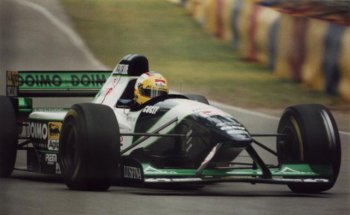
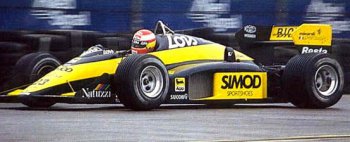
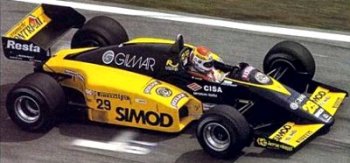
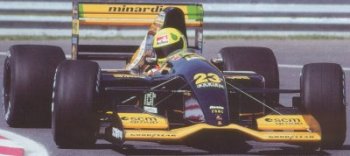
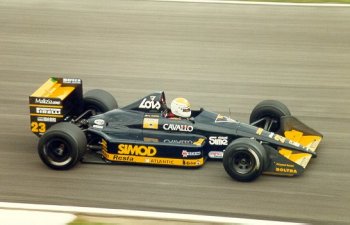
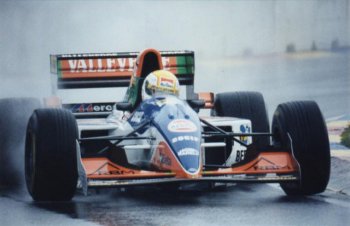 |
|
Six Minardi Formula One
cars to have graced the Grand Prix race
tracks: the M185, M187,
M188, M192, M194 and M195 |
|
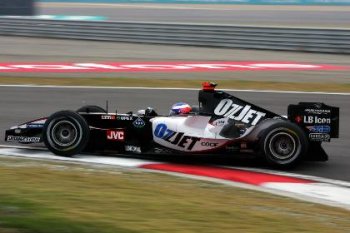 |
|
The final act: the
Minardi-Cosworth PS05 racer in action over this
weekend during practice for today's Chinese Grand
Prix |
|
|
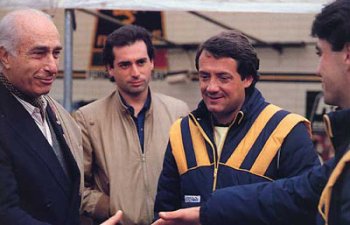 |
|
Giancalo Minardi (seen
here with Juan Mauel Fangio) founded the eponymous
Faenza-based Formula One team a name the has been
present in Grand Prix racing for 20 years |
|
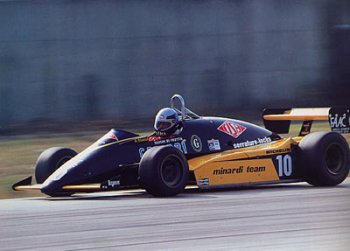 |
|
The Minardi team
originally competed in the European F2
Championship: here Alessandro Naninni is seen during
1983 |
|
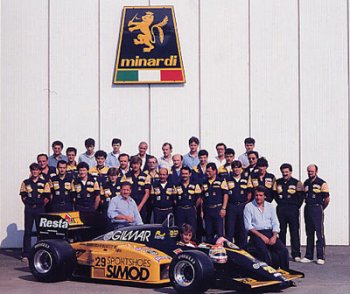 |
|
The Minardi team made the step up to F1 in 1985 -
here the team and its driver Pierluigi Martini pose
with the new M185 |
|
|
One of the most satisfying aspects of the 1999 season was
the excellent reliability of the M01, which helped its
drivers to 10 top-10 finishes. The 2000 campaign marked
Minardi's 16th year in Formula One, and although the team
did not succeed in scoring any points during the course of
the season, it retained its tenth-place ranking in the World
Championship, finishing ahead of the notably better-funded
Prost squad.
The 2001 season marked another watershed for Minardi, the
withdrawal of a major sponsor at the end of the previous
year leaving the team in difficult financial circumstances.
As a result, it was acquired by UK-based Australian
businessman, Paul Stoddart, head of the European Aviation
Group of companies, and merged with his European Formula
Racing operation, based in Ledbury, England. His plan was to
retain Minardi's distinct character in the Formula One
paddock, while providing EFR personnel, technical expertise
and financial stability to strengthen the team and improve
its overall competitiveness in the future. The team finished
11th in the 2001 World Constructors' Championship.
Minardi's 2002 effort featured the all-new KL Minardi PS02
chassis, powered by Asiatech's AT02 engine, a strengthened
management team, including new Sporting Director, John
Walton, and increased commercial backing, in particular,
from Malaysia. The season opened with a fantastic result,
when new Australian signing, Mark Webber, finished fifth in
his "home" Grand Prix. The resulting two points turned out
to be extremely valuable, as they secured ninth place for
Minardi in the 2002 World Constructors' Championship
standings.
In 2003, Minardi entered the third year of Paul Stoddart's
five-year plan for the team with an improved technical
package based around an evolution of the PS02 chassis and
powerful Cosworth Racing CR-3 V10 engine. The high point of
the season was undoubtedly Jos Verstappen's
weather-assisted, provisional pole position at the
conclusion of Friday's first qualifying session for the
French Grand Prix. Unfortunately, a lack of funding
ultimately meant technical development of the European
Minardi PS03 was severely limited, however, and the team
slipped back to tenth place in the World Championship as a
result. There was one other remarkable event involving
Minardi in 2003. It occurred on the Sunday of the team's
301st Grand Prix, and spoke volumes for the contribution
made by the Faenza squad to the sport of Formula One. With
the inclusion of Marc Gene, deputising for the injured Ralf
Schumacher at Williams, eight of the 20 competitors who
lined up for the start of the Italian Grand Prix were either
current, or former, Minardi drivers - 40 per cent of the
grid. The 2003 season may not have been a notably successful
one for the team, but that statistic filled everyone
concerned with considerable pride.
For the 2004 season, there was a further evolution of the
Minardi PS02/PS03 design concept, designated PS04B, with
power again provided by Cosworth Racing's potent, 72-degree,
CR-3L V10 engine. In the cockpit, Rome's Gianmaria "Gimmi"
Bruni steped up from the role of official tester to become a
race driver, and he was joined by Zsolt Baumgartner, who
became Hungary's first full-time Formula One competitor.
This year the team again campaigned a Cosworth engine, the
chassis evolving to become the PS05. The team started with
young drivers Patrick Friesacher and Christijan Albers, the
former giving way mid-season to Robert Doornbos, making it
an all-Dutch line-up, a first for F1. High point of the
final season for Minardi was both cars finishing in the
points at the farcical United States Grand Prix, where only
the six Bridgestone-shod runners actually started, the
Michelin supplied teams having withdrawn on safety grounds.
Owner Paul Stoddart made it quite obvious during the course
of the year that the team was up for sale and the autumn
announcement that Red Bull (who had only last year bought
the defunct Jaguar team) was buying the outfit was not
unexpected, thus consigning another F1 name to the history
books for good.
|
|
|
|
![]()
![]()